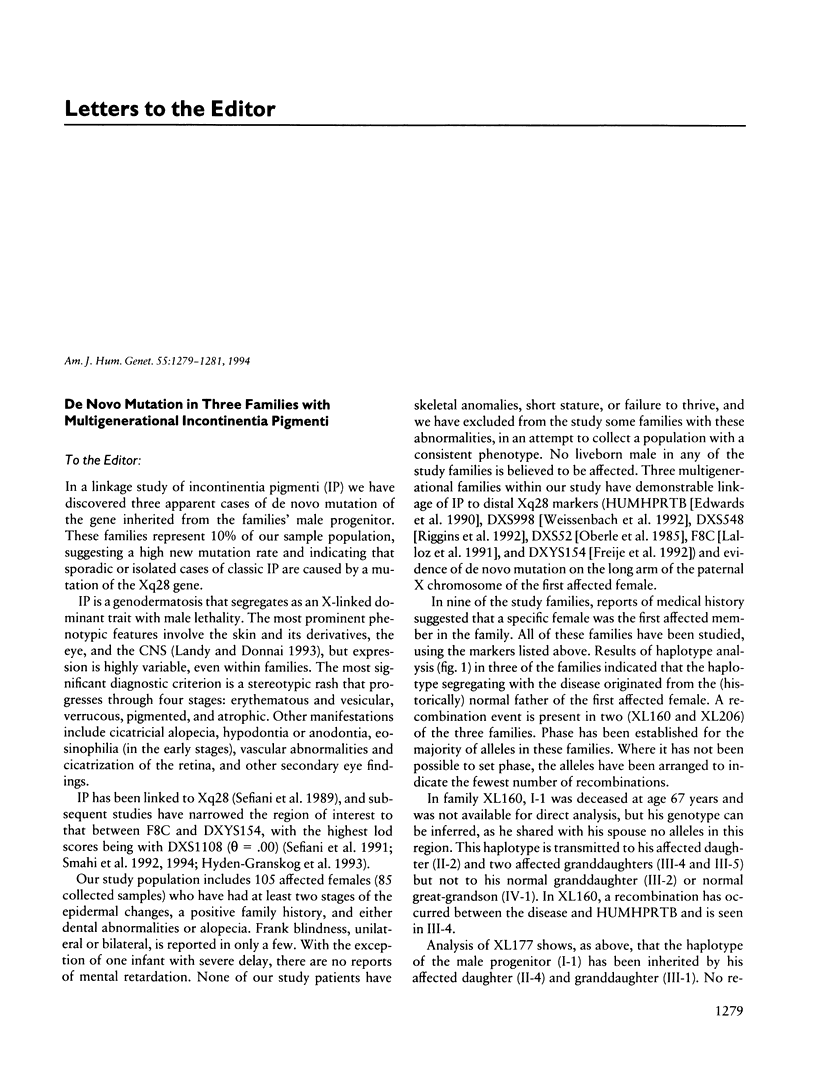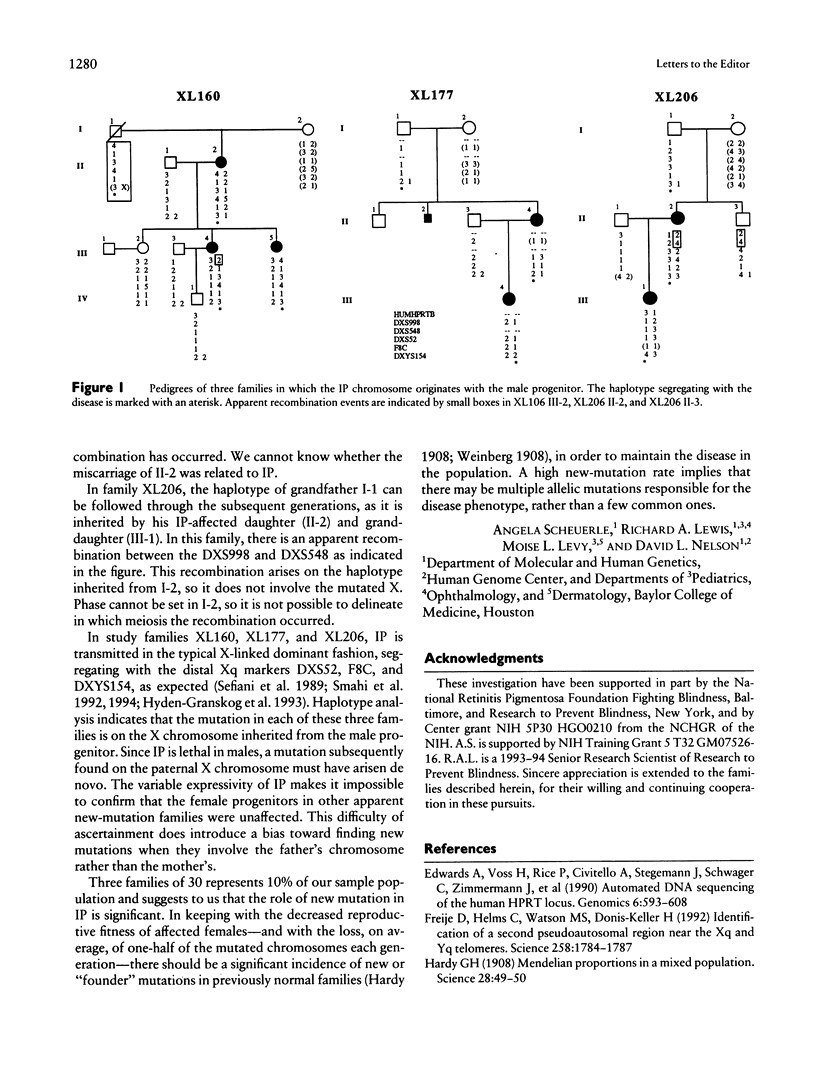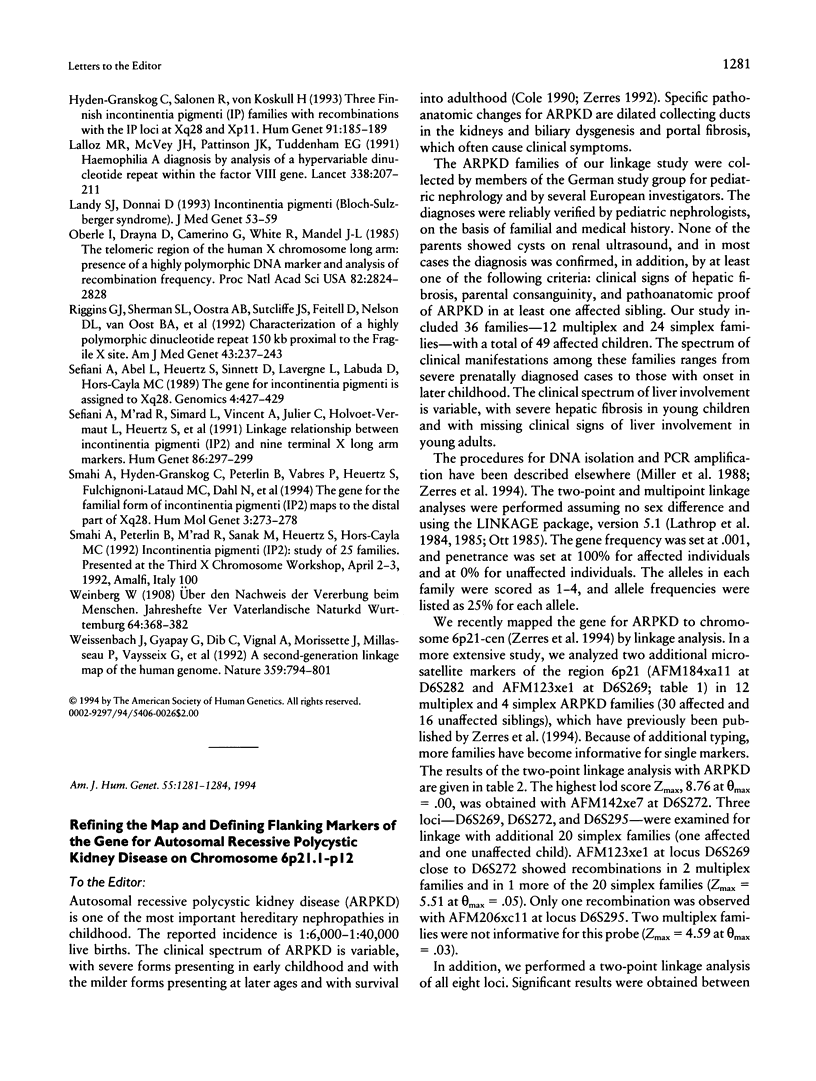Full text
PDF


Selected References
These references are in PubMed. This may not be the complete list of references from this article.
- Edwards A., Voss H., Rice P., Civitello A., Stegemann J., Schwager C., Zimmermann J., Erfle H., Caskey C. T., Ansorge W. Automated DNA sequencing of the human HPRT locus. Genomics. 1990 Apr;6(4):593–608. doi: 10.1016/0888-7543(90)90493-e. [DOI] [PubMed] [Google Scholar]
- Freije D., Helms C., Watson M. S., Donis-Keller H. Identification of a second pseudoautosomal region near the Xq and Yq telomeres. Science. 1992 Dec 11;258(5089):1784–1787. doi: 10.1126/science.1465614. [DOI] [PubMed] [Google Scholar]
- Hardy G. H. MENDELIAN PROPORTIONS IN A MIXED POPULATION. Science. 1908 Jul 10;28(706):49–50. doi: 10.1126/science.28.706.49. [DOI] [PubMed] [Google Scholar]
- Hydén-Granskog C., Salonen R., von Koskull H. Three Finnish incontinentia pigmenti (IP) families with recombinations with the IP loci at Xq28 and Xp11. Hum Genet. 1993 Mar;91(2):185–189. doi: 10.1007/BF00222723. [DOI] [PubMed] [Google Scholar]
- Lalloz M. R., McVey J. H., Pattinson J. K., Tuddenham E. G. Haemophilia A diagnosis by analysis of a hypervariable dinucleotide repeat within the factor VIII gene. Lancet. 1991 Jul 27;338(8761):207–211. doi: 10.1016/0140-6736(91)90348-s. [DOI] [PubMed] [Google Scholar]
- Landy S. J., Donnai D. Incontinentia pigmenti (Bloch-Sulzberger syndrome). J Med Genet. 1993 Jan;30(1):53–59. doi: 10.1136/jmg.30.1.53. [DOI] [PMC free article] [PubMed] [Google Scholar]
- Oberlé I., Drayna D., Camerino G., White R., Mandel J. L. The telomeric region of the human X chromosome long arm: presence of a highly polymorphic DNA marker and analysis of recombination frequency. Proc Natl Acad Sci U S A. 1985 May;82(9):2824–2828. doi: 10.1073/pnas.82.9.2824. [DOI] [PMC free article] [PubMed] [Google Scholar]
- Riggins G. J., Sherman S. L., Oostra B. A., Sutcliffe J. S., Feitell D., Nelson D. L., van Oost B. A., Smits A. P., Ramos F. J., Pfendner E. Characterization of a highly polymorphic dinucleotide repeat 150 KB proximal to the fragile X site. 1992 Apr 15-May 1Am J Med Genet. 43(1-2):237–243. doi: 10.1002/ajmg.1320430138. [DOI] [PubMed] [Google Scholar]
- Sefiani A., Abel L., Heuertz S., Sinnett D., Lavergne L., Labuda D., Hors-Cayla M. C. The gene for incontinentia pigmenti is assigned to Xq28. Genomics. 1989 Apr;4(3):427–429. doi: 10.1016/0888-7543(89)90350-9. [DOI] [PubMed] [Google Scholar]
- Sefiani A., M'rad R., Simard L., Vincent A., Julier C., Holvoet-Vermaut L., Heuertz S., Dahl N., Stalder J. F., Peter M. O. Linkage relationship between incontinentia pigmenti (IP2) and nine terminal X long arm markers. Hum Genet. 1991 Jan;86(3):297–299. doi: 10.1007/BF00202414. [DOI] [PubMed] [Google Scholar]
- Smahi A., Hyden-Granskog C., Peterlin B., Vabres P., Heuertz S., Fulchignoni-Lataud M. C., Dahl N., Labrune P., Le Marec B., Piussan C. The gene for the familial form of incontinentia pigmenti (IP2) maps to the distal part of Xq28. Hum Mol Genet. 1994 Feb;3(2):273–278. doi: 10.1093/hmg/3.2.273. [DOI] [PubMed] [Google Scholar]
- Weissenbach J., Gyapay G., Dib C., Vignal A., Morissette J., Millasseau P., Vaysseix G., Lathrop M. A second-generation linkage map of the human genome. Nature. 1992 Oct 29;359(6398):794–801. doi: 10.1038/359794a0. [DOI] [PubMed] [Google Scholar]


